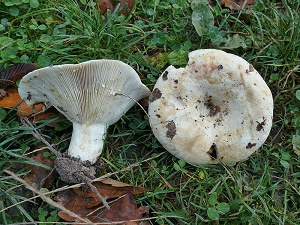| Lactarius vellereus (Fr.:Fr.) Fr. |
|
|
|
|
|
|
The cap is white, stained with ochre at the centre. The cap surface is without concentric bands, not viscid nor sticky. The stem is white, without ring. The flesh is white, turning yellow slowly when exposed to air; its taste is hot (but with mild or acrid latex); the odour is faint, pleasant; its texture is grainy (breaking like a chalk stick), exuding when cut a white milk, turning slowly yellow. The gills are white then pale ochre, decurrent to adnate, distant . The spore print is white. This species is mycorrhizal. It grows in broad-leaved (rarely coniferous) woods, on a rather clayey-calcareous soil, with beech, oak mostly, also with chestnut, pine, larch. The fruiting period takes place from June to December.
Chemical tests : none. Distinctive features : White cap, with ochre patches, slightly woolly and funnel-shaped, short; inrolled margin; rather distant gills; flesh exuding white milk, unchanging, mild but acrid when tasted with flesh; cap often soiled by humus (underground growth) Lactarius vellereus is infrequent and scattered in the forest of Rambouillet, and is frequent, more generally speaking . | ||
|
page updated on 14/01/18

